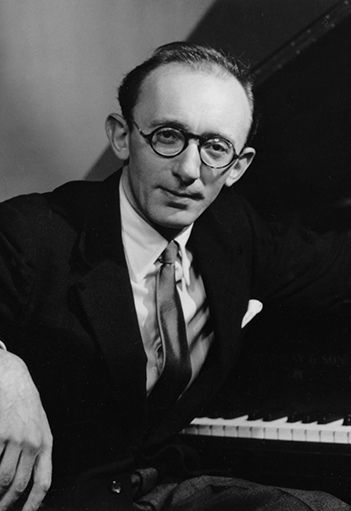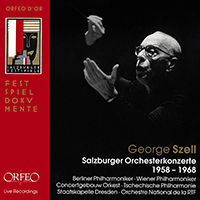Clifford Curzon
Curzon’s mother was an amateur singer and his father a dealer in antiques. His uncle was the composer Albert Ketelbey, who had a huge success around the time of World War I with his compositions In a Persian Market and In a Monastery Garden. Curzon was not a child prodigy—his brother and sister received higher marks in piano examinations—yet Clifford was a sensitive child who realised that he felt and reacted differently from his family to the things around him.
Curzon entered London’s Royal Academy of Music in 1919 where he studied with Charles Reddie who had been a pupil of Bernard Stavenhagen. He won many prizes, including the MacFarren Gold Medal, and then continued his studies with Katherine Goodson, a Leschetizky pupil. At the Royal Academy Curzon was encouraged by Sir Henry Wood who conducted his first appearance at Queen’s Hall; at the age of sixteen he took part in a performance of Bach’s Concerto for Three Keyboards. A sub-professorship at the Royal Academy of Music was interrupted in 1928 when Curzon went to Berlin to study for two years with Artur Schnabel. Curzon later said, ‘It was Schnabel who really revealed to me the path I must take. He widened and deepened my whole approach to music and piano playing.’ After Berlin, where Curzon made his debut in 1930, he went to Paris where he was influenced by Wanda Landowska and Nadia Boulanger. In 1931 Curzon married Lucille Wallace, a harpsichordist who was studying in Paris with Landowska, and in the mid-1930s bought a house near Salzburg, but in 1932 he returned to London and resigned from the Royal Academy (he never enjoyed teaching) in order to pursue a performing career. During this time Curzon received work via the British Council who chose him to tour Europe with violist Lionel Tertis in 1937, and the following year sent him on a solo tour of Europe.
Curzon’s orchestral debut at Carnegie Hall in New York in 1939 consisted of three concertos: the Concerto in E flat by John Ireland, Mozart’s Concerto in A major K. 488 and Tchaikovsky’s Concerto No 1 in B flat minor Op. 23. Curzon was not under any management and had hired the hall himself, so after the success of the concert he was signed by Arthur Judson’s management to tour America the following year. However, the outbreak of World War II meant that Curzon did not return to America until after the war, although from then on he enjoyed great success in America and Europe and had a career as a performer both as recitalist and in chamber music.
A believer in working hard at the piano, Curzon practised between four and eight hours a day throughout his life. The most recognisable factor of his playing is his sound. To him, the sound created at the keyboard was as important as the technical command. He would annotate his scores in different coloured pencils, concentrating and working on every phrase, every line, every note, to get precisely the sound he wanted. His repertoire, like Schnabel’s, was based around Mozart, Beethoven and Schubert, but it also included Romantics such as Liszt, Tchaikovsky, Franck and Brahms. As Curzon grew older some works were dropped from his repertoire, although in his younger days he played such rarely-heard compositions as d’Indy’s Symphonie sur un chant montagnard français Op. 25, Paderewski’s Polish Fantasy, and the Piano Concerto by Delius (a work he revived at a Prom performance in 1981). In fact, he championed modern British works by Britten, Berkeley, Rawsthorne and Lambert and in 1926 gave the British première of the Ballade by Germaine Tailleferre.
Curzon suffered from stage fright throughout his career and found public performance and recording difficult. This could be one reason why his discography is so small for a pianist who recorded between 1937 and the early 1970s. There is also the fact that he refused to have many recordings released; yet because of this small number of discs, almost every Curzon recording affords a distillation of his finest points. Also, he preferred to record in long takes, striving to get the structure and meaning of the work across as he would in recital. Curzon made his first recording for Decca in 1937; with his mentor Henry Wood, he recorded the ‘Wanderer’ Fantasy of Schubert in the arrangement for piano and orchestra by Liszt. During World War II Curzon made a number of recordings for Decca, including Schubert’s Impromptus D. 899 and some duets with Benjamin Britten; but some major works he recorded were never released, amongst which were Schumann’s Piano Sonata No. 2 in G minor, some late Brahms pieces, and Tchaikovsky’s Piano Concerto No. 1 with Malcolm Sargent. At the end of the war Curzon recorded the first of his three versions of Brahms’s Piano Concerto No. 1 with the National Symphony Orchestra and Enrique Jorda and, in 1949, Beethoven’s ‘Emperor’ Concerto with the London Philharmonic Orchestra and George Szell. This and many other recordings from this time have recently been reissued in three handsome sets of compact discs from Decca.
At the dawn of the LP era Curzon recorded popular concertos, including Rachmaninov’s Piano Concerto No. 2 Op.18 and some that he would record again later in stereo, among them works by Grieg and Tchaikovsky. The most important LP recordings are a disc of his only studio performances of Schumann: the Fantasie Op. 17 and Kinderszenen Op. 15 (March 1954); a Liszt recital, including the Piano Sonata in B minor (September 1963); Beethoven’s ‘Emperor’ Concerto with Hans Knappertsbusch (June 1957); a disc of Brahms’s Piano Sonata in F minor (December 1962); and the third of Curzon’s recordings of the Piano Concerto No. 1 (May 1962). An excellent mono version of this concerto with Eduard van Beinum and the Concertgebouw Orchestra from 1953 is complemented by the stereo remake with George Szell in 1962. A review in The Gramophone stated, ‘I am quite sure that this is the best available recording of Brahms’s Piano Concerto, and indeed one of the best performances of the work I have ever heard.’
Curzon was also responsible for some of the most sublime chamber music recordings with piano. Particularly fine are his accounts of César Franck’s Piano Quintet with members of the Vienna Philharmonic, Schubert’s ‘Trout’ Quintet, and Dvořák’s Piano Quintet in A major. A disc of Mozart Piano Quartets K. 478 and K. 493 with the Amadeus Quartet recorded in September 1952 is another gem in Curzon’s chamber discography. Other notable recordings include a strong, heroic performance of Beethoven’s ‘Eroica’ Variations from 1971 and two outstanding Schubert sonatas: the D major D. 850 and one of the most glorious versions of the B flat Sonata D. 960 from September 1972, which ranks with those of Schnabel and Uchida.
Curzon live was unpredictable and could be disastrous. A recently issued performance of Liszt’s Sonata in B minor is shocking in its inaccuracies and insecurity. William Mann apparently referred to Curzon’s interpretation of this work as ‘a serious misrepresentation of the work’s musical conception’ yet a live performance of Brahms’s Piano Quintet in F minor Op. 34 from the Royal Festival Hall in London in 1974 is absolutely stunning in its conviction. More successful live performances have appeared on the Audite label which has published four Mozart piano concertos and Beethoven’s Piano Concertos Nos 4 and 5 with Rafael Kubelík and the Bavarian Radio Symphony Orchestra. Orfeo have issued a live recital from the 1974 Salzburg Festival.
One unusual departure from Decca occurred in the early 1950s when Curzon joined the Budapest Quartet in works by Brahms, Schumann and Dvořák for Columbia. These have recently been issued on compact disc by Naxos.
Curzon was an unusual pianist who could be equally convincing in both Schubert and Liszt, whose performance depended on the way he felt at that moment, and in whom the British public did not realise what a talent their country had produced. When he was on form his music-making was often revelatory. As Lionel Salter wrote of the recording of Liszt’s Liebestraum No. 3, ‘It is almost as if one were hearing this piece for the first time… this is the most beautiful performance of this morceau I have ever heard.’ Curzon often said that his largest audience was to be found outside of the British Isles and it is astonishing to read that he only gave two solo recitals at London’s Royal Festival Hall, both at the end of his career in 1976 and 1977.
© Naxos Rights International Ltd. — Jonathan Summers (A–Z of Pianists, Naxos 8.558107–10)


















